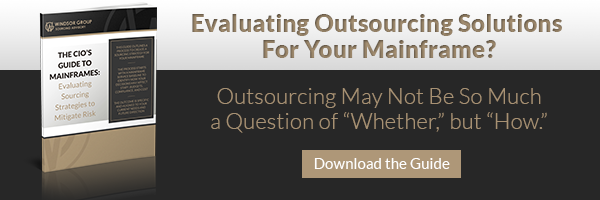.jpg) Researching mainframe outsourcing providers should be an enlightening experience, not a rocky road. Here are some hints to smooth the way:
Researching mainframe outsourcing providers should be an enlightening experience, not a rocky road. Here are some hints to smooth the way:
Hint #1: This one’s obvious, but easy to overlook.
Mainframe outsourcing providers differ widely in what they bring to your table and how they work. Choosing the right one is far more complex than simply shooting out some RFPs and waiting to see who can do the work for least cost. Even how you craft those RFPs can help or hinder your efforts to find the best IT alternatives, including the most effective provider.
If you’re ready to consider providers, you’ve probably identified the new mainframe solutions you want – or you’re getting close to that point. But did you know that narrowing your list of potential providers before you finalize your solution could actually bring you better results? Why not let them weigh in, using their specialized expertise to recommend solution details as part of the selection process?
Hint #2: Know thyself.
-
The delivery solutions you select affect which providers you’ll want to consider. Are you looking for a few commoditized services? Incorporating distributed systems or, eventually, a total transformation to the cloud?
-
Every company has cultural preferences corporate foibles, so you want a provider that can help ameliorate any negatives and play to your unique strengths.
-
Your working style matters. Planning and monitoring performance is a team effort that cannot succeed without a friendly, trusting working relationship. Outstanding expertise isn’t enough in a provider.
Hint #3: Know your goals.
Ideally, mainframe outsourcing providers should be with you for the long haul, but what does that really mean for your enterprise? It’s not uncommon to think of outsourcing merely in terms of acquired third-party services, but you can draft a partnership agreement that has far more reach than that, if you’re so inclined.
You’ll need detailed SLAs and associated benchmarks that address necessary service and support tasks. But some mainframe outsourcing providers can work with you to drive internal innovation via IT, develop new products or focus on systematically exceeding baseline SLAs in terms of timing or scope. Money is the driver here, so how you incentivize your provider, and for what, directly determines your outcomes.
Hint #4: Get help.
One of the primary reasons for outsourcing is to offload work that isn’t mission-critical, allowing your employees to concentrate more strategically on corporate growth and development. Certainly your mainframes are fundamental to your enterprise’s ability to function and serve customers, but major companies have long since determined it’s more cost-effective and more productive to target limited resources elsewhere than IT.
That said, you’re smart to get professional assistance right from the beginning, so the transition you plan is the one that will serve you best. Hiring a sourcing consultant adds strengths you don’t possess internally – marketplace familiarity and unbiased insight to help you make well-informed decisions.
How much time do you really want to spend researching possible providers? Do you even know the right questions to ask? Instead of starting from scratch, you can step into the process where it counts most – choosing among a short list of mainframe outsourcing providers your consultant knows from personal experience are best-suited to handle the work you need done, in a way that weaves comfortably into the fabric of your enterprise.
Hint #5: You may want more than one provider.
Depending on the configuration and complexity of your mainframe transformation, you could realize the best outcomes by distributing the work among two or even more providers, to most effectively take advantage of each one’s core capabilities.
Hybridization is the new normal when it comes to IT, and why not? You want solutions that are entirely tailored to your enterprise and your business goals, and the only way to achieve that is by assembling the puzzle pieces that will afford your organization a custom fit.


